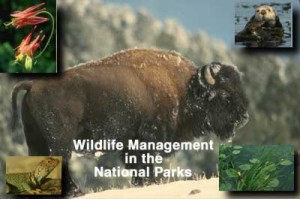YELLOWSTONE BISON & BRUCELLOSIS ACTORS

Greater Yellowstone Coalition:
- The Greater Yellowstone Coalition was formed
in 1983. It has over 7600 members, and the goal of the GYC is
to maintain wildlife diversity and stop habitat fragmentation
within the GYE.
- The GYC blames the Montana Department of Livestock
and Montana governor Marc Racicot for the slaughtering of Yellowstone
Bison. The GYC has argued that both Racicot and the DOL have
chosen to kill large numbers of bison which never posed any
threat to cattle.
- The GYC is currently working to stop bison slaughter
and helping to ensure cattle and bison do not have to share
the same land. The GYC has supported public land acquisition
in order to help reach this goal.
- The GYC has published numerous articles trying
to prove that the recent slaughtering of bison was unnecessary
and that up to eighty percent of the slaughtered bison were
brucellosis free.
- Throughout its campaign, the GYC has continuously
criticized the DOL and urged citizens get involved with GYC
and help "Save the bison."
For more information: http://www.greateryellowstone.org/

The National Parks and Conservation Association (NPCA):
- The National Parks and Conservation Association was
created in 1919 and its objective ever since then has been to
"Preserve, Protect, and Enhance" the National Park System
- After 1083 bison were killed in the harsh winter of 1996-97,
The National Parks and Conservation Association created
the Bison Belong Campaign.
- The Bison Belong Campaign argues that Bison need to
be saved because they are a symbol of the American Wilderness
and because bison are crucial to the economic and ecological
health of Southern Montana.
- The NPCA states that the fear of brucellosis transmission
to cattle is severely overblown and that State of Montana has
made a mistake by underestimated the importance of Bison to
the Yellowstone Region.
- The main way the Bison Belong Campaign is trying to
help the bison is by pressing the state and federal agencies
to agree on a management solution before another severe winter
kills mass amounts of bison.
For more information: http://www.npca.org/bison
 USDI’s
National Park Service:
USDI’s
National Park Service:
-
The USDA’s Animal and Plant Inspection Service (APHIS) has
been "working cooperatively with the livestock industry
and the State animal health authorities to eradicate brucellosis
from the United States." Also, APHIS is trying to "protect"
both the livestock and bison from diseases introduced by outside
sources.
-
APHIS has argued that both cattle and bison should be vaccinated,
tested, and if positive for brucellosis, removed. This management
plan, argues APHIS, is the only way to get a healthy and free
roaming bison population within the GYE.
-
APHIS is the most involved of the USDA’s agencies with brucellosis.
This is because APHIS is in charge of classifying states according
to their brucella infection rate in cattle.
-
The different classifications are Class Free, Class A, Class
B, and Class C. The lower the class, the more stringent the
interstate regulations on movement of cattle. Also, because
forty-three states are currently class free, hardly anyone
is willing to risk doing business with any state whose cattle
are not class free. A Class C classification can lead to federal
quarantine. Montana and Wyoming have been Class Free since
1985 and Idaho has been class free since 1990.
For more information: http://www.aphis.usda.gov/vs/nahps/Brucellosis/cattle.htm
, APHIS Public Affairs (202) 720-2511

USDA’s Animal and Plant Health Inspection Service:
·
The USDA’s Animal
and Plant Inspection Service (APHIS) has been “working cooperatively
with the livestock industry and the State animal health authorities
to eradicate brucellosis from the United States.”
Also, APHIS is trying to “protect” both the livestock
and bison from diseases introduced by outside sources.
·
APHIS has argued that
both cattle and bison should be vaccinated, tested, and if positive
for brucellosis, removed.
This management plan, argues APHIS, is the only way to
get a healthy and free roaming bison population within the GYE.
·
APHIS is the most involved
of the USDA’s agencies with brucellosis.
This is because APHIS is in charge of classifying states
according to their brucella infection rate in cattle.
·
The different classifications
are Class Free, Class A, Class B, and Class C. The lower the class, the more stringent
the interstate regulations on movement of cattle. Also, because forty-three states are currently
class free, hardly anyone is willing to risk doing business with
any state whose cattle are not class free.
A Class C classification can lead to federal quarantine. Montana and Wyoming have been Class Free
since 1985 and Idaho has been class free since 1990.
For more
information: http://www.aphis.usda.gov/vs/nahps/Brucellosis/cattle.htm , APHIS Public Affairs (202) 720-2511
The
Greater Yellowstone Interagency Brucellosis Committee:
- The Greater Yellowstone Interagency Brucellosis Committee
(GYIBC) created its memorandum of understanding
in 1995, which defined the problem of brucellosis and what plan
of action was to be taken to solve the problem.
- The goal the GYIBC since 1995 has been to protect and maintain
the bison and elk populations in the GYE, while also protecting
the economic viability of the livestock industry in Montana,
Wyoming, and Idaho.
- The GYIBC is an objective committee where everyone impacted
by brucellosis is represented equally and given equally consideration.
The GYIBC is trying to do what's best for both sides on the
issue of brucellosis.
- Because the committee has no legal power, it can only make
suggestions as to what should be done about brucellosis.
- The GYIBC is the largest Brucellosis committee in existence.
- The GYIBC has set a goal of trying to eradicate brucellosis
from the GYE by 2010. All of the following groups have voting
representatives on the GYIBC:
- USDA - Forest Service, Animal and Plant Health Inspection
Service, Agricultural Resource Service
- USDI - National Park Service, Bureau of Land Management,
Fish and Wildlife Service, Geological Survey
- Idaho Department of Fish and Game
- Wyoming Fish and Game Department
- Idaho Department of Agriculture
- Wyoming Livestock Board
- Montana Department of Livestock
For more Information: www.nps.gov/gyibc
Montana
Department of Livestock:
- The number one priority of the Montana Department of Livestock
is to protect and maintain the health and economic viability
of the livestock in Montana.
- Since 1995, the Montana Department of Livestock has had the
mandate from the legislature to deal with bison which leave
YNP in a way that ensures the safety of the Montana cattle.
- here are two ways the DOL deals with Bison who leave YNP.
The first way is to try and scare the bison back into the park.
This process is called "hazing." However, snowmobiles
have made trails which create easy exits out of the park for
bison. Because of this, more and more bison are able to leave
YNP and the "hazers" are less able to scare all of
the bison back into the park. When the bison are not scared
back into the park by hazing, they are trapped in holding pens
and then tested for brucellosis. If the bison are pregnant or
test seropositive for brucellosis, then they are sent
to slaughter. Non-pregnant bison that test negative are released
back into the park.
- The question is whether or not the seropositive bison are
a threat to cattle and deserve to be slaughtered? The DOL feels
the answer is yes and that any chance of cattle infection is
too much of a risk to take. Because the DOL has been given lead
authority under the Interim Bison Management Act, the
DOL is able to implement policies which work in its best interest.
- The livestock industry is vital to the economic success of
Montana. The DOL argues that Montana is entrenched in a battle
against brucellosis and must fight until there is no longer
a threat of transmission. Also the DOL argues that the Bison
population in YNP is five times above the number required to
maintain long-term viability and that the bison population in
YNP will not be threatened by the DOL brucellosis eradication
efforts.
For more Information: http://www.liv.state.mt.us/NEWS.HTM


 USDI’s
National Park Service:
USDI’s
National Park Service: